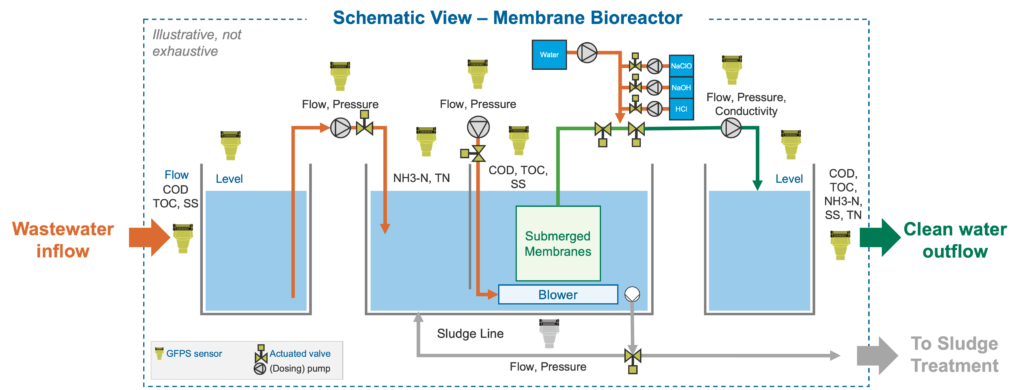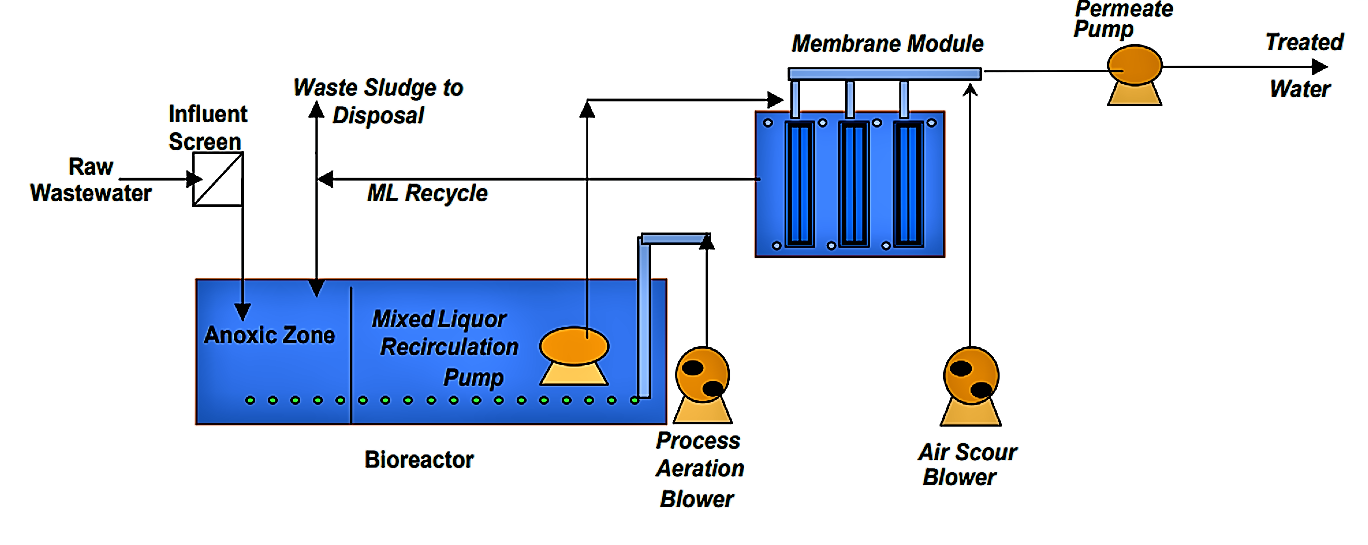Membrane Bioreactor as a Sustainable Solution for High-Volume Wastewater Treatment
Membrane Bioreactor as a Sustainable Solution for High-Volume Wastewater Treatment
Blog Article
The Benefits of Membrane Bioreactors in Lasting Wastewater Monitoring
Membrane layer bioreactors (MBRs) stand for a crucial development in sustainable wastewater administration, properly combining biological therapy with advanced membrane filtration technology. This assimilation not just enhances effluent top quality by efficiently getting rid of pollutants yet likewise opens up opportunities for water reuse in various applications, hence dealing with journalism need for resource conservation. The compact design of MBRs adds to considerable reductions in environmental impact and operational costs. As the demand for sustainable remedies heightens, exploring the multifaceted advantages of MBRs may expose unanticipated ramifications for the future of wastewater treatment systems.
Overview of Membrane Bioreactors
Membrane bioreactors (MBRs) stand for a significant advancement in wastewater therapy technology, integrating organic deterioration with membrane layer filtration to enhance the efficiency of the therapy procedure. This cutting-edge system incorporates the advantages of standard activated sludge processes with membrane technology, enabling boosted solid-liquid separation. MBRs make use of semi-permeable membranes to different cured water from biomass, causing top notch effluent that can be reused or safely released into the setting.
The operational layout of MBRs generally includes a bioreactor where microbes damage down raw material, complied with by a membrane layer system that filters the combined alcohol. This configuration not only minimizes the impact of the therapy center however additionally permits greater biomass concentrations and decreased hydraulic retention times. MBRs are qualified of treating a bigger variety of impurities, including nutrients and microorganisms, making them suitable for numerous applications, from community wastewater treatment to industrial effluent processing.
The combination of MBRs into wastewater administration systems is a sign of a growing fad towards efficient and sustainable methods in ecological design. Their capacity to generate high-quality effluent while minimizing space needs settings MBR modern technology as a principal in contemporary wastewater therapy solutions.
Enhanced Effluent High Quality

The membrane purification procedure works as a physical barrier, enabling the retention of microbes and particle issue, which adds to a clearer and cleaner effluent (Membrane Bioreactor). Moreover, MBRs run at higher biomass focus than conventional turned on sludge systems, advertising extra efficient biodegradation of contaminants. This leads to a decrease in biochemical oxygen need (BOD) and complete put on hold solids (TSS) levels in the final effluent
Furthermore, MBRs show excellent performance in dealing with difficult wastewater compositions, such as industrial effluents and wastewater with high nutrient loads. Because of this, the effluent generated is commonly of higher top quality, enabling for more versatile disposal alternatives and lowered ecological effect. Ultimately, the boosted effluent top quality accomplished with MBR technology highlights its critical duty beforehand sustainable wastewater administration techniques.
Water Reuse Opportunities
The high-grade effluent created by membrane bioreactors (MBRs) opens up significant opportunities for water reuse in numerous applications. MBRs efficiently get rid of contaminants, including microorganisms, suspended solids, and raw material, resulting in treated water that satisfies or surpasses regulatory requirements for reuse. This quality permits for the implementation of water recycling campaigns across varied markets.
One noticeable application is in farming, where treated wastewater can be used for irrigation, advertising lasting farming techniques while saving fresh water resources. Furthermore, MBR-treated effluent can be made use of for industrial check my blog processes such as cooling, cleaning, and as a procedure water source, considerably reducing the need for safe and clean water in these procedures.
In city settings, MBRs promote making use of redeemed water for landscape watering, bathroom flushing, and other non-potable uses, adding to the overall durability of water systems. The assimilation of MBR technology in decentralized systems help in managing local water needs, specifically in water-scarce regions.
Minimized Environmental Effect
Exactly how can the adoption of membrane layer bioreactors (MBRs) add to a reduced ecological effect in wastewater management? MBRs substantially enhance the treatment efficiency of wastewater while reducing ecological disturbances. Membrane Bioreactor.
Moreover, MBRs operate at reduced hydraulic retention times this content compared to standard systems, causing smaller therapy plant impacts. This compact style minimizes land use, consequently maintaining all-natural environments and biodiversity. The procedure also produces less sludge than conventional approaches, alleviating disposal challenges and decreasing greenhouse gas discharges related to sludge monitoring.
In addition, MBRs facilitate the recovery of beneficial sources, such as water and nutrients, adding to a round economic climate. By enabling water reuse for irrigation or commercial processes, MBRs help reduce freshwater scarcity, hence promoting lasting water make use of methods. Inevitably, the fostering of MBR innovation stands for a considerable stride in the direction of reducing the environmental effect of wastewater administration systems.
Financial Advantages of MBRs

Furthermore, MBRs help with the production of high-grade effluent, which can be reused for numerous applications, such as farming irrigation and industrial processes - Membrane Bioreactor. This reuse ability can substantially reduce water procurement expenses, supplying a monetary incentive for industries encountering stringent water guidelines
The small style of MBR systems likewise results in reduced land demands, which is particularly valuable in city locations where genuine estate is costly. By reducing area, industries and communities can conserve on land purchase and upkeep expenses.
Furthermore, MBRs typically need much less frequent maintenance and have a longer lifespan than standard systems, better adding to cost savings. In recap, the economic benefits of MBRs-- ranging from lowered operational prices to land financial savings and effluent reuse-- make them an engaging option for lasting wastewater monitoring, supplying both immediate and long-lasting financial benefits.
Final Thought
In addition, MBRs contribute to lowered ecological impacts through small layouts and reduced sludge generation. Economic advantages additionally enhance their stability, making MBRs an appealing remedy for attending to the obstacles of wastewater therapy and advertising lasting source monitoring.
Membrane layer bioreactors (MBRs) stand for an essential you could try here innovation in lasting wastewater management, successfully combining organic treatment with innovative membrane layer filtration innovation.Membrane bioreactors (MBRs) represent a significant development in wastewater treatment technology, integrating organic degradation with membrane filtering to enhance the performance of the treatment procedure.Achieving improved effluent quality is one of the most substantial advantages of using membrane bioreactors (MBRs) in wastewater therapy.In addition, MBRs show superb performance in treating challenging wastewater make-ups, such as industrial effluents and wastewater with high nutrient tons.Incorporating membrane bioreactors (MBRs) into wastewater monitoring not just lowers ecological impact but also presents substantial financial advantages.
Report this page